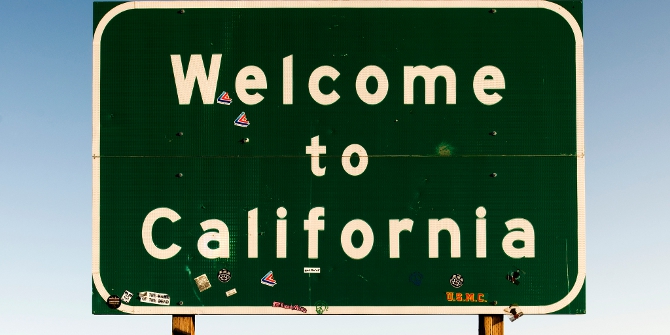 In July, Silicon Valley entrepreneur, Tim Draper, submitted more than one million signatures in a petition that would put a proposal to split California into six new states on the ballot for the 2016 state elections. Raphael Sonenshein writes that if approved, the proposal would make the new state of Silicon Valley the wealthiest in the country, and the others, some of the poorest. He argues that Draper’s plan for new states to compete with each other by letting counties sign on with other states is likely to baffle voters, and that it may fail to win public support, because even in California voters are cautious when it comes to risky government innovation, especially when the initiative comes from a business leader acting as a political guru.
In July, Silicon Valley entrepreneur, Tim Draper, submitted more than one million signatures in a petition that would put a proposal to split California into six new states on the ballot for the 2016 state elections. Raphael Sonenshein writes that if approved, the proposal would make the new state of Silicon Valley the wealthiest in the country, and the others, some of the poorest. He argues that Draper’s plan for new states to compete with each other by letting counties sign on with other states is likely to baffle voters, and that it may fail to win public support, because even in California voters are cautious when it comes to risky government innovation, especially when the initiative comes from a business leader acting as a political guru.
Tim Draper’s proposal to divide California into six states may or may not make it to the November 2016 ballot. While this plan is very unlikely to ever become reality even if comes before the voters, it does indicate how some American entrepreneurs see themselves in the civic arena.
Americans can be very skeptical about government, and have at times looked outside traditional politics for leadership. Once upon a time, it was the military leader, the man on the white horse, who would lead us to strength. Other than professional politicians, generals had the best chance of becoming president. Consider Washington, Jackson, Grant, and Eisenhower.
There has been a tendency in recent American culture to glorify business leaders as practical geniuses able to get things done. With the decline in faith in government at all levels, the role once filled by military leaders has seemed more than inviting to those in the business world. After all, shouldn’t government be run just like a business? Shouldn’t the president, the governor, and the mayor be successful CEOs?
Let’s add to the mix the cult of Silicon Valley, now the star of its own television series. The mighty legend of the brilliant techies who can find solutions to any problem has elevated a whole region to cultural prominence.
Enter Tim Draper, a successful Silicon Valley entrepreneur. Like a number of business Republicans in solidly Democratic California, Draper has reinvented himself as a “decline to state” (giving no party affiliation), a safe position in a state where the Republican brand is in the toilet. And his proposal to divide the state six ways would indeed devastate Democratic presidential campaigns by diluting the electoral votes of California.
While Silicon Valley’s entrepreneurs lean toward the Democrats, Draper’s disdain for the slog of government is not alien at all to the region’s culture. Writing in The New Yorker in May, George Packer noted that in the Silicon Valley world “government is considered slow, staffed by mediocrities, ridden with obsolete rules and inefficiencies.”
The cleverness of the six-state proposal lies in getting us to think about the other five states, when it is really about the new state of Silicon Valley. It’s easiest to see it through the eyes of a successful Silicon Valley entrepreneur who has founded his own Draper University of Heroes at Stanford University. Not just folks who are good at making money, but actual heroes. Like many reforms, the six state proposal enhances the role and stature of its main advocate, and the region of the state that he inhabits. As Philip Bump recently wrote in the Washington Post, “this entire plan is really about creating Silicon Valley as its own state. Therefore Silicon Valley ….gets to make its politics and its money more dense, and everyone in the idyllic dream of Silicon Valley gets to be happy.” Bump notes that the wealthy new state would not have to see its tax money go to support less affluent sections of the former California.

The Draper plan essentially allows Silicon Valley to emerge from the shadow of state and local government into its own power system. Silicon Valley would immediately become the wealthiest state in the nation. It would have its own governor (perhaps Draper?), two United States Senators, and all the accouterments of an American state. The appeal to the rest of us is that we would have our own states too, although some would be much poorer than before.
Draper’s argument, often made by business people who don’t know or respect government very much, is that the system is in complete collapse. There is the accident of bad timing here, as California has gone in the last two years from cautionary tale (another Greece?) to role model. Budget deficits have become budget surpluses. There is new money for public education. The state is leading the nation in extending health coverage to the uninsured. Right now, Democratic one-party control seems to be working in government rather than causing gridlock. But the case against government is rather resistant to changing circumstances and to actual government performance.
When it comes down to actual voting, Americans can be skeptical of the business leader as political guru. What wins plaudits in business may be fatal politically, as Mitt Romney discovered in 2012 when his business practices became fodder for the Obama campaign. When tech executive Meg Whitman spent a fortune to run against now-Governor Jerry Brown in 2010, she lost in a runaway. Whitman had been certain that a dynamic business leader would easily dispatch what seemed to her to be a tired old Democratic warhorse.
Draper’s view of how his six state plan would work relies on the sort of business thinking that often baffles voters. He calls for individual counties to be able to sign on to a neighboring state, noting how great it would be if political communities could compete with each other just like dynamic startup companies. Competition like that rarely helps most of us. The Central Valley, which would become the poorest state in the union under Draper’s plan, would not welcome the chance to become governmental entrepreneurs in a system built in Silicon Valley’s image.
Perhaps the oddest element of this proposal is that Draper names himself as the legal representative of the entire plan. …”(I)n recognition of his personal and financial stake in the enforcement, implementation, and defense of the initiative…” he declares himself the state’s agent who will supervise the Attorney General in any litigation.
Even in California, voters are not risk takers, a style that dominates Draper’s Heroes curriculum. (Draper calls himself the “Riskmaster.”) There is a reason that American states have remained largely intact, and that secession movements rarely succeed. Many ballot measures, even in “cutting edge” California, fail because when it comes to government, we are cautious innovators. And despite all of our bitter complaints about political leaders, we often turn at the end of the day to those who run the government for a living. Perhaps it’s a bit dispiriting but it’s also a reminder that government is not just a game for amateurs.
Featured image credit: Curtis Perry CC BY NC SA 2.0
Please read our comments policy before commenting.
Note: This article gives the views of the author, and not the position of USApp– American Politics and Policy, nor of the London School of Economics.
Shortened URL for this post: http://bit.ly/1p4VJIR
______________________
 Raphael J. Sonenshein – Pat Brown Institute for Public Affairs, California State University Los Angeles
Raphael J. Sonenshein – Pat Brown Institute for Public Affairs, California State University Los Angeles
Raphael J. Sonenshein is the Executive Director of the Pat Brown Institute for Public Affairs at California State University Los Angeles.







Warning. This is a sample of what the future holds for the United States that will some day divide into many regional nations, each independent of Washington, DC, as the Empire, now in its zenith, follows the history of all empires, and collapses. The same applies to China and, of course, the first to fall will be the weak common currency union known as the European Union.
And, as always, when one empire dissolves, another replaces it. That is why Black Africa is destined, perhaps in my lifetime or that of your children or grandchildren, to finally also become a powerful empire — economically and militarily — that rules what is left worldwide as Climate Change speeds the destruction of others. A single Empire is its destiny and hopefully it will not remember how Black folk have been enslaved for the past three thousand years — hopefully.